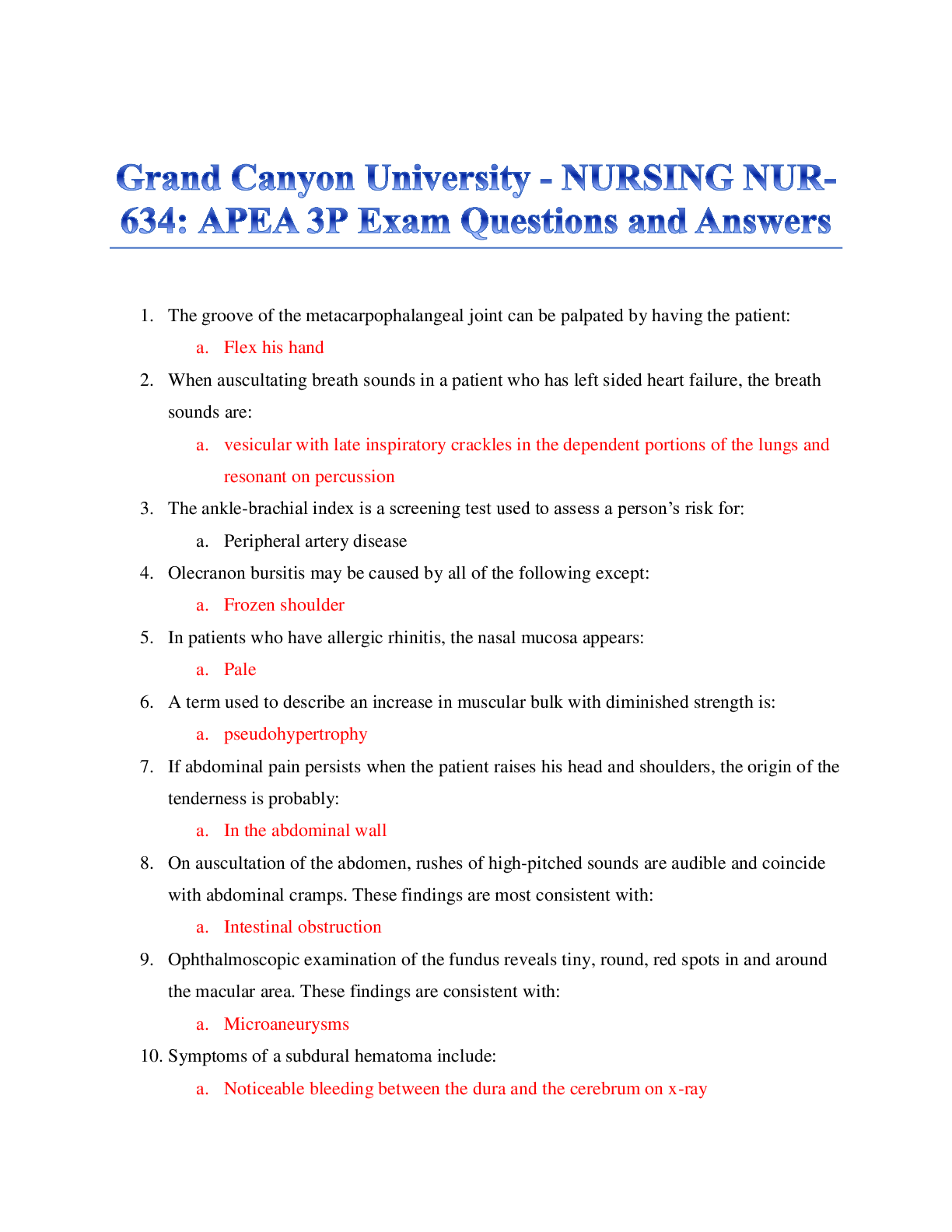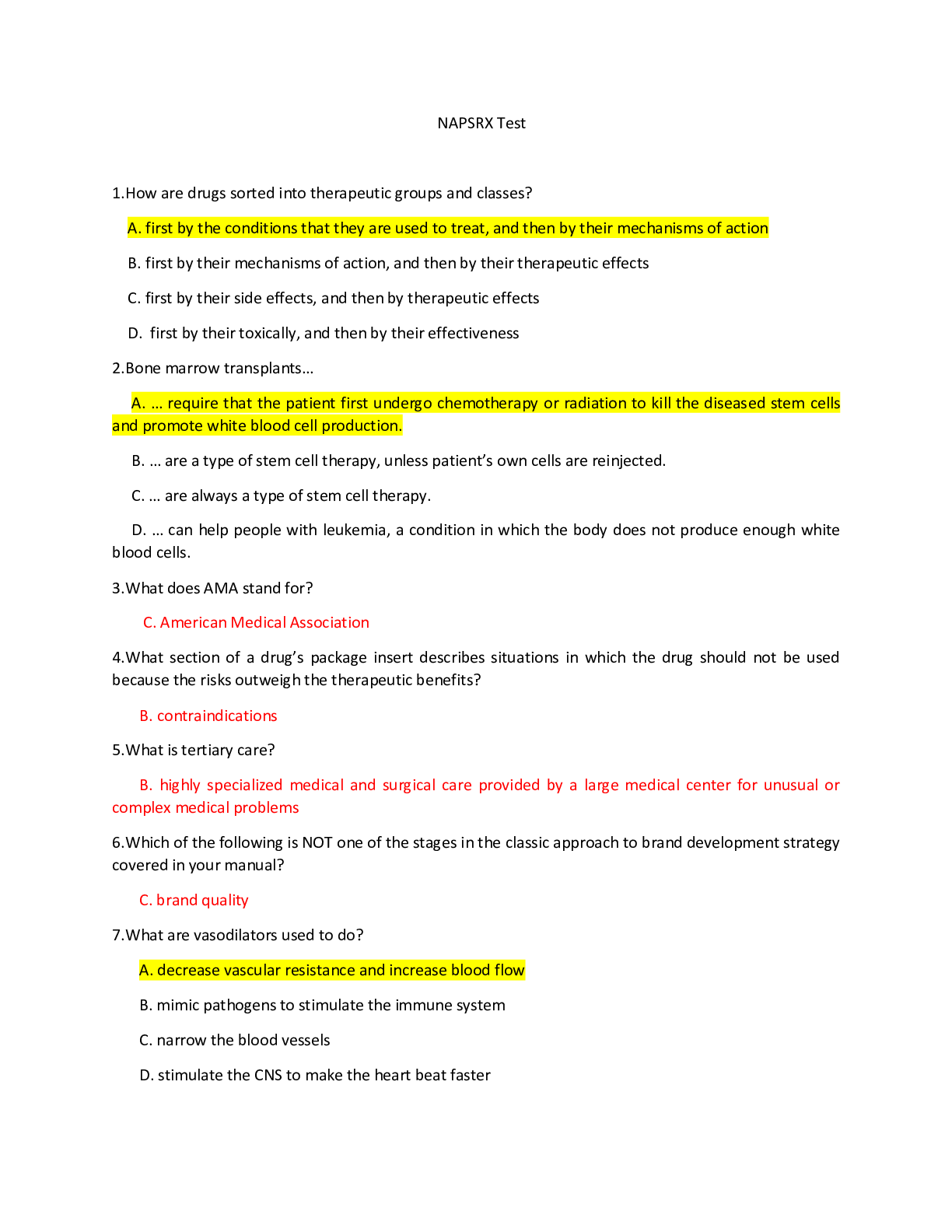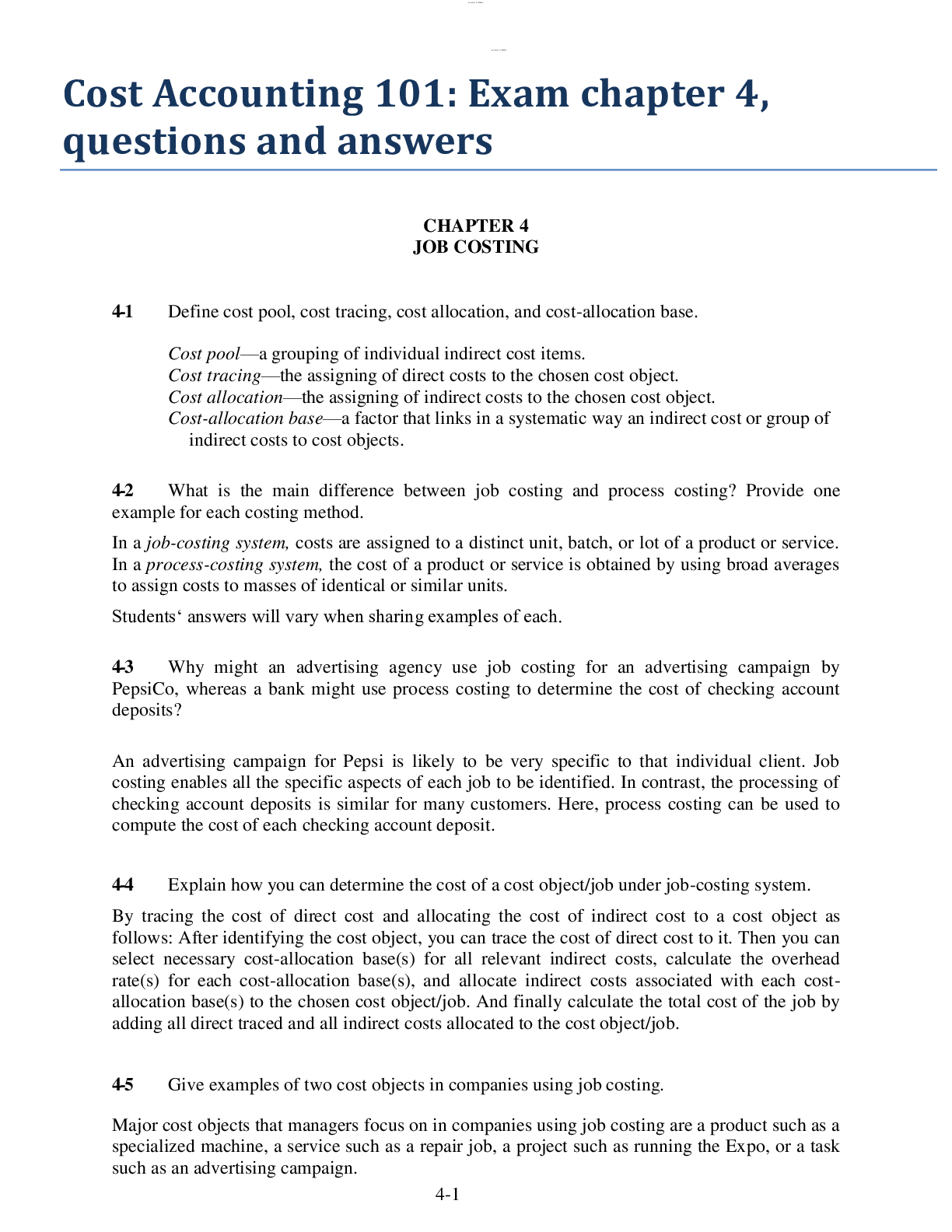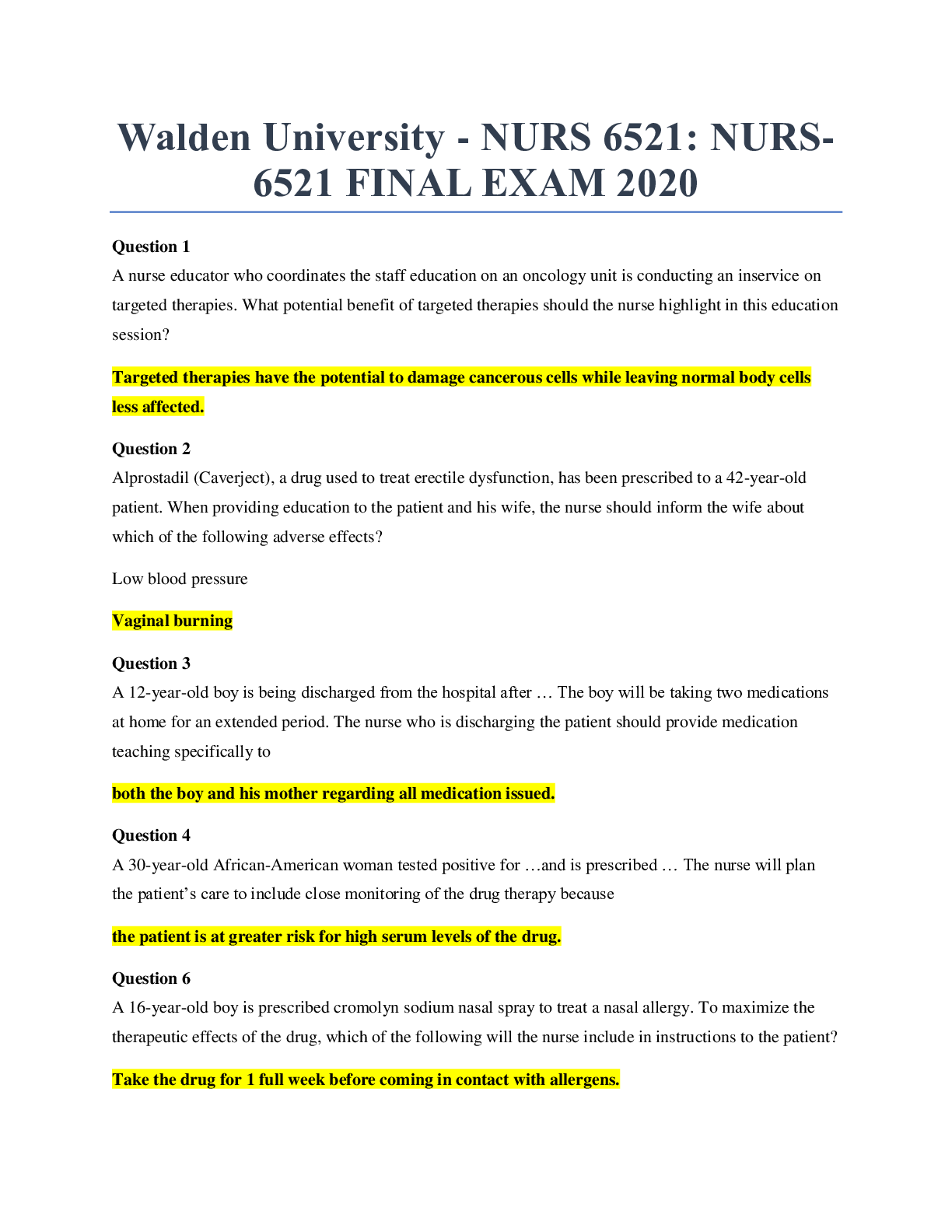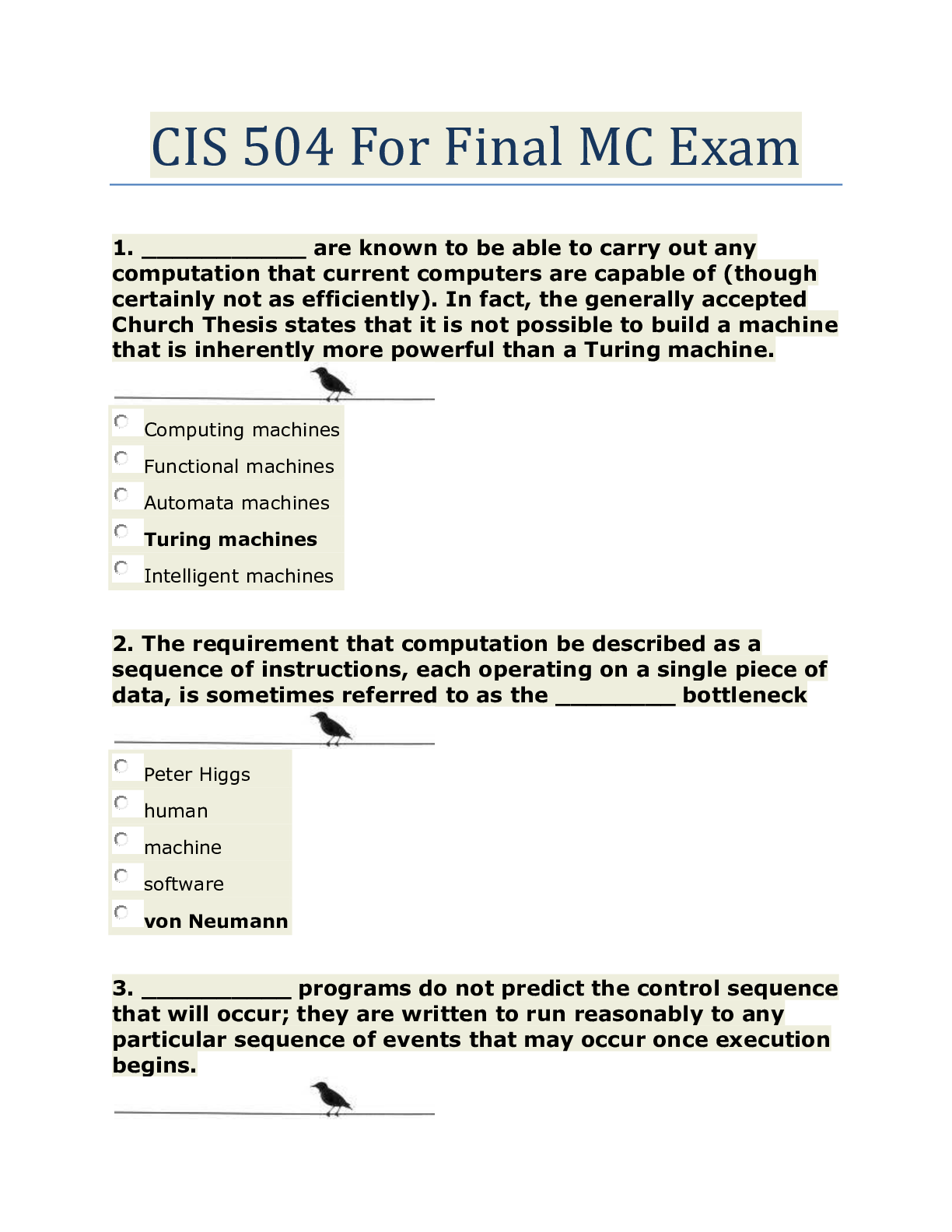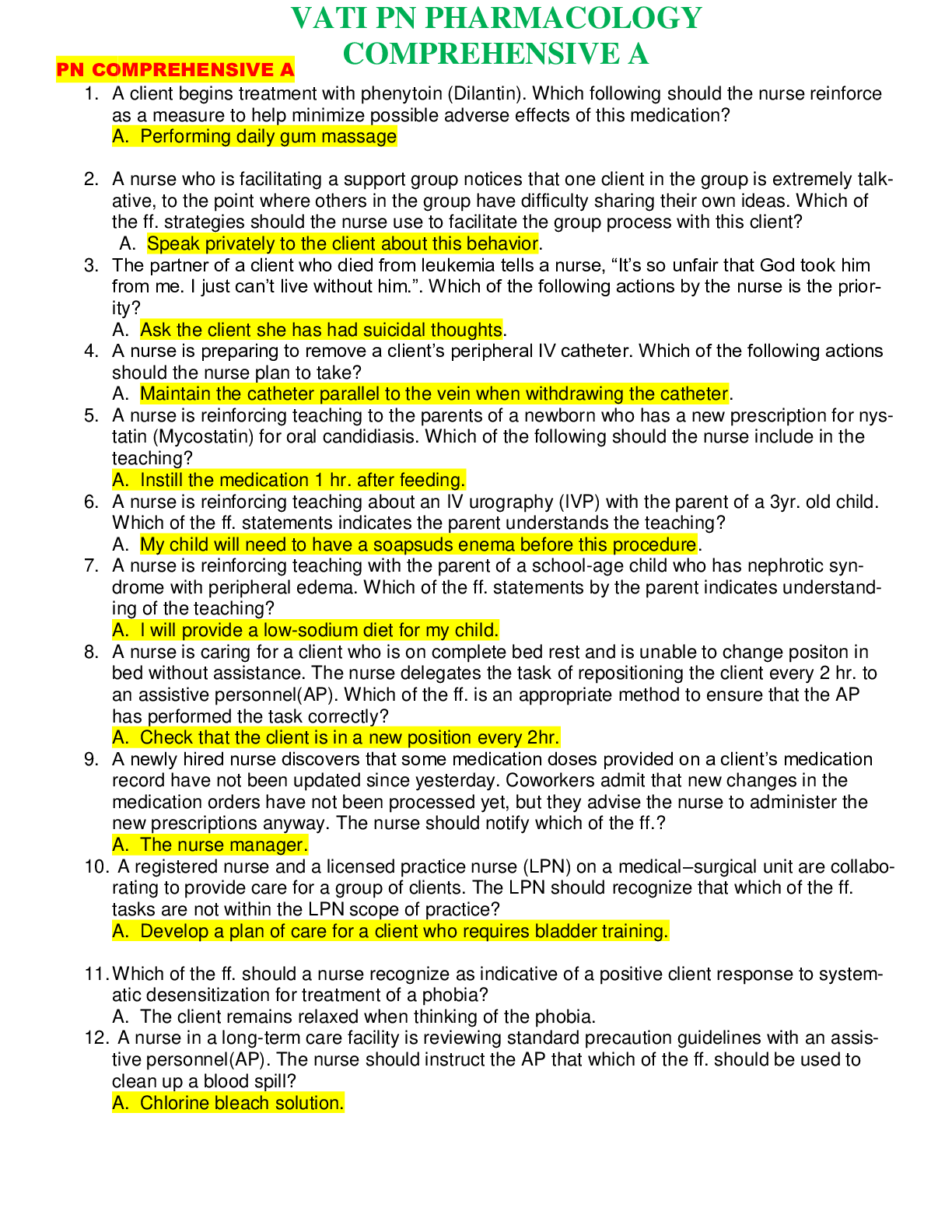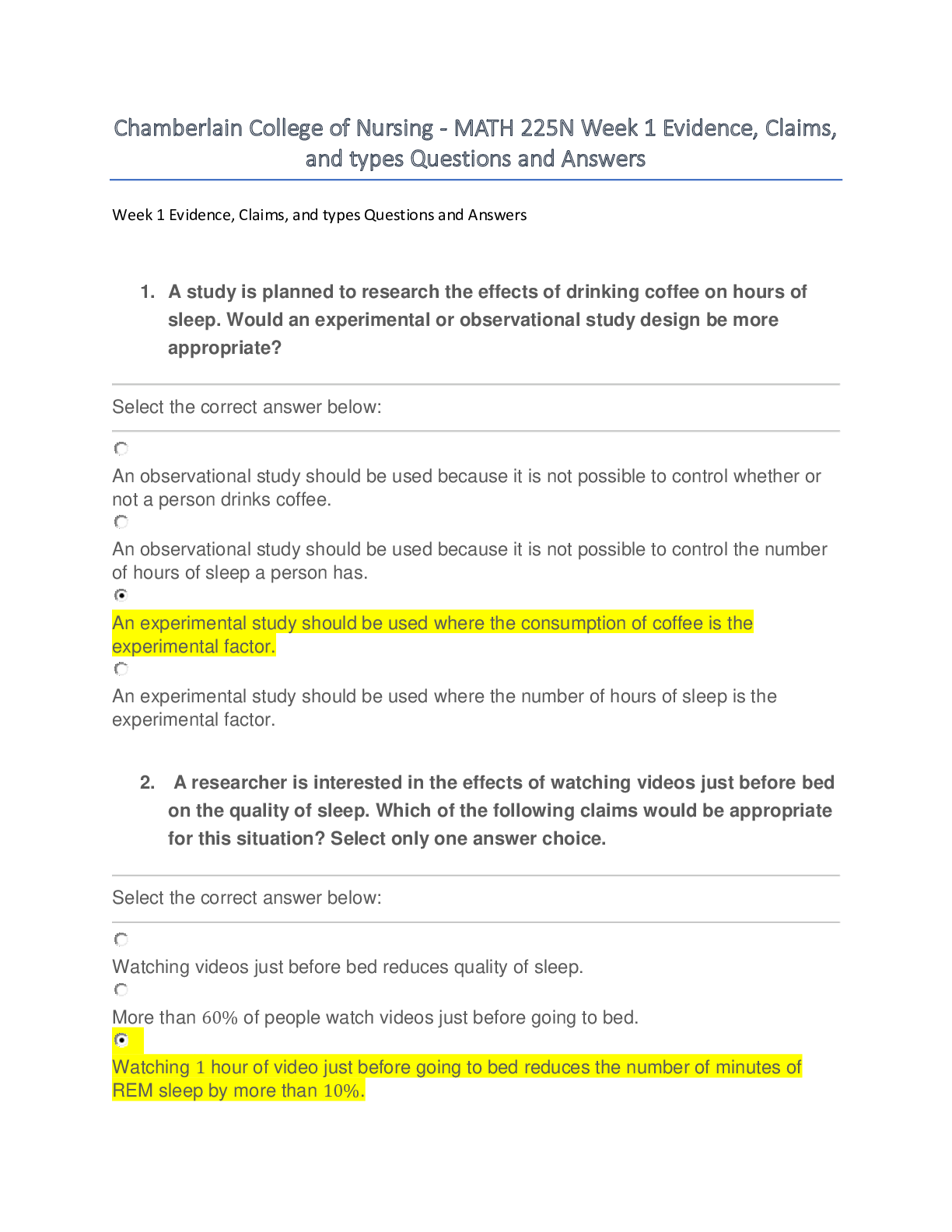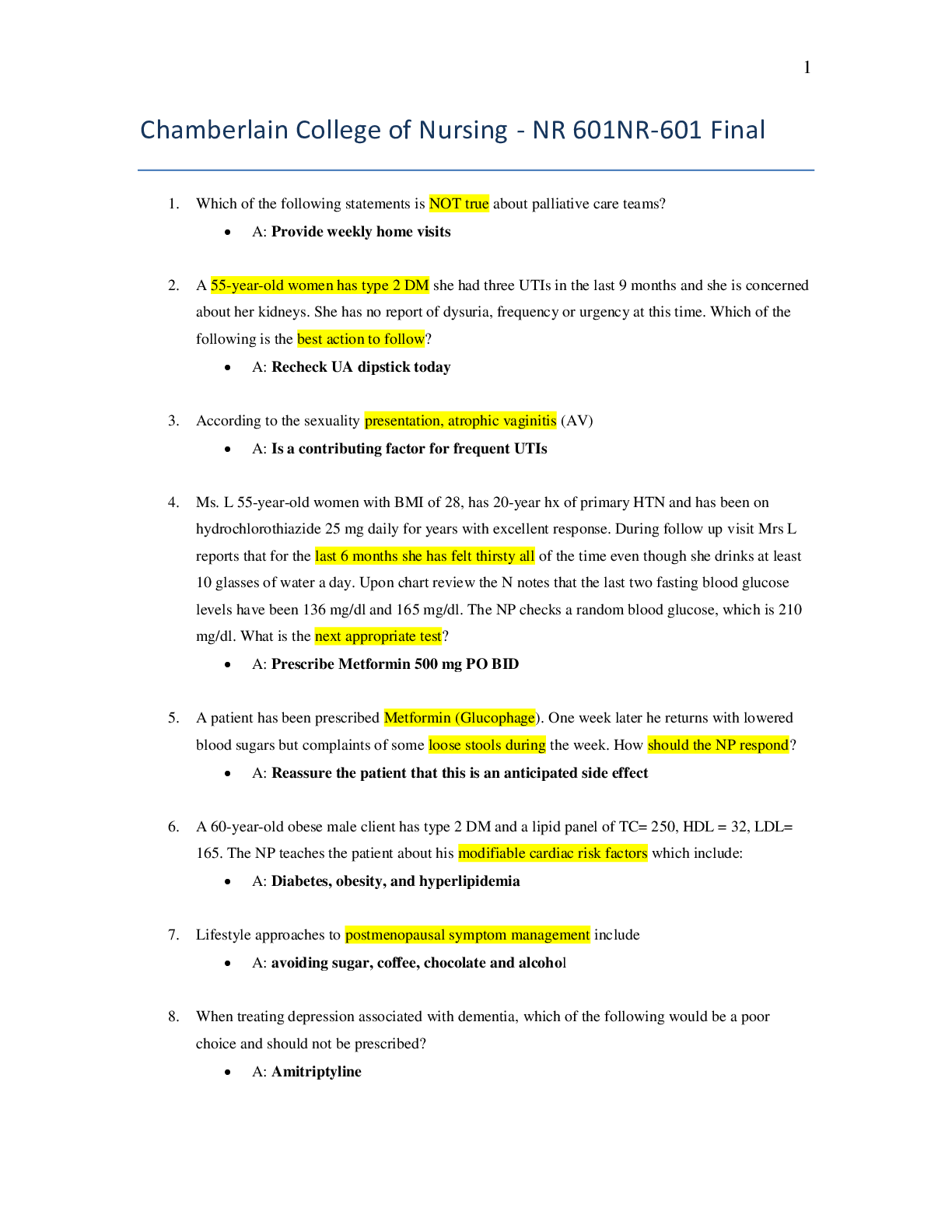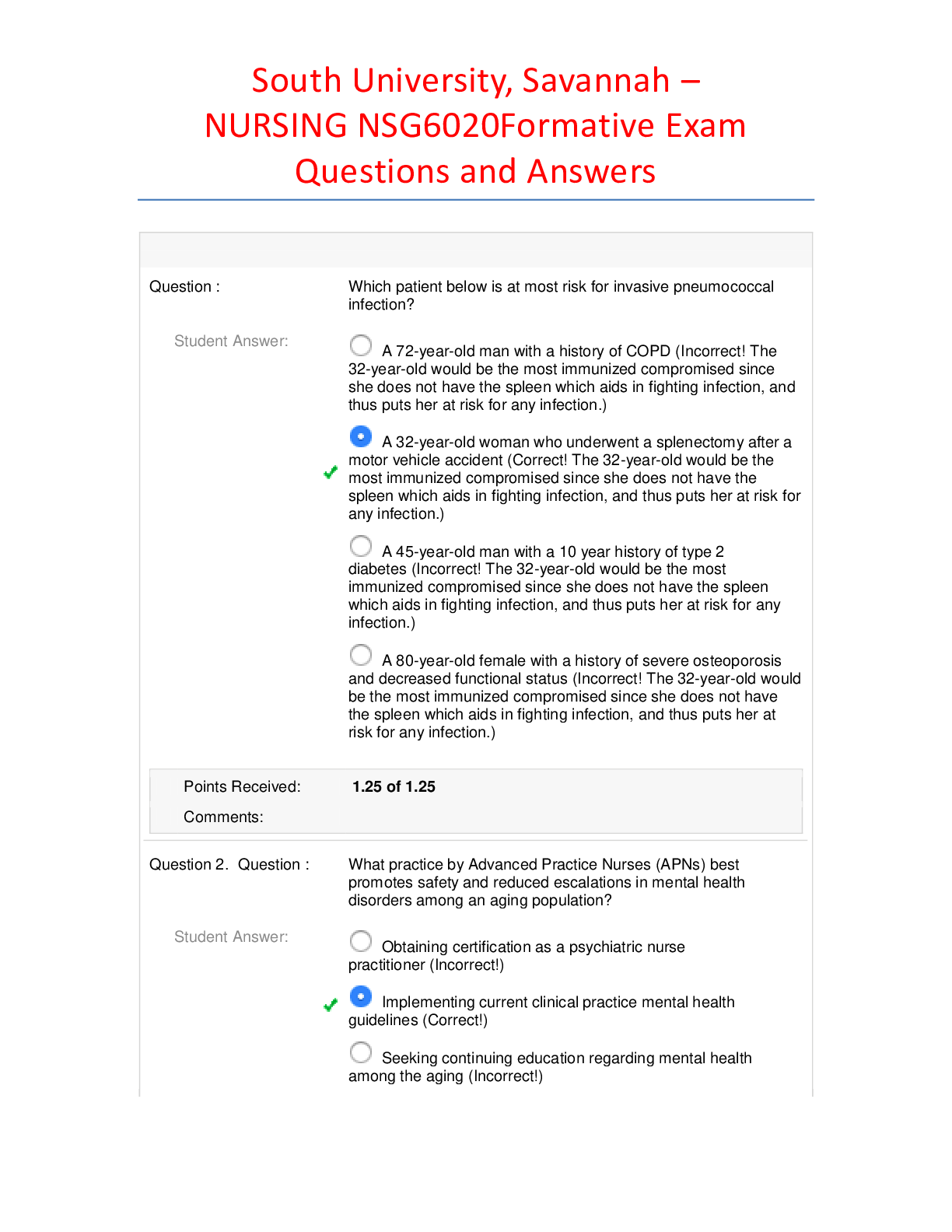Biology > EXAM > [Solved] BIO 250 Unit Exam 1 Part 1. Questions And Answers. Complete Solution. (All)
[Solved] BIO 250 Unit Exam 1 Part 1. Questions And Answers. Complete Solution.
Document Content and Description Below
[Solved] BIO 250 Unit Exam 1 Part 1 Question 1 of 25 4.0 / 4.0 Points In contrast to the nervous system, the endocrine system uses only one method of communication: signaling. • A. e... lectrical • B. chemical • C. direct • D. “hard wired” • E. transmitter Feedback:Good work; your answer is correct! Question 2 of 25 4.0 / 4.0 Points The function of the placental hormone human placental lactogen (hPL) is to . • A. prepare the breasts for lactation • B. nourish the placenta • C. regulate the menstrual cycle • D. help the placenta to mature • E. All of the above are true. Feedback:Good work; your answer is correct! Question 3 of 25 4.0 / 4.0 Points One of the major functions of the adrenal glands is to respond to . • A. light and dark • B. stress • C. pain • D. hunger and thirst • E. low insulin levels Feedback:Good work; your answer is correct! Question 4 of 25 4.0 / 4.0 Points The adrenal glands are wedges of glandular and neuroendocrine tissue adhering to the top of the . • A. spleen • B. kidneys • C. hypothalamus • D. thyroid gland • E. liver Feedback:Good work; your answer is correct! Question 5 of 25 4.0 / 4.0 Points The parathyroid glands are small structures located on the posterior thyroid gland that produce parathyroid hormone (PTH), which regulates blood levels. • A. adrenalin • B. potassium • C. calcium • D. thyroid hormone • E. insulin Feedback:Good work; your answer is correct! Question 6 of 25 4.0 / 4.0 Points Which of the following statements about insulin is true? • A. Insulin acts as a transport protein, carrying glucose across the cell membrane. • B. Insulin facilitates the movement of intracellular glucose transporters to the cell membrane. • C. Insulin stimulates the breakdown of stored glycogen into glucose. • D. Insulin stimulates the kidneys to reabsorb glucose into the bloodstream. • E. Two of the above are true statements. Feedback:Good work; your answer is correct! Question 7 of 25 4.0 / 4.0 Points Hormones regulate certain target cell responses. These can include which of the following? • A. Growth and development of tissue • B. Sexual function • C. All of the above are correct. • D. Metabolism • E. Fluid balance Feedback:Good work; your answer is correct! Question 8 of 25 4.0 / 4.0 Points The beta cells of the pancreatic islets produce and secrete . • A. insulin • B. glucagon • C. epinephrine • D. betagen • E. Both A and B Feedback:Good work; your answer is correct! Question 9 of 25 4.0 / 4.0 Points The nervous system uses which of the following types of intercellular communication? • A. Hormonal and chemical • B. Electrical and hormonal • C. Direct and hormonal • D. Electrical and chemical • E. Direct and chemical Feedback:Good work; your answer is correct! Question 10 of 25 4.0 / 4.0 Points The alpha cells of the pancreatic islets produce and secrete . • A. insulin • B. glucagon • C. epinephrine • D. alphagen • E. All of the above Feedback:Good work; your answer is correct! Question 11 of 25 0.0 / 4.0 Points How can the anterior part of the pituitary gland control the secretion of thyroid hormones? • A. Some thyroid hormones are actually produced in the pituitary gland. • B. If there are not enough thyroid hormones available in the body, the anterior pituitary can release thyroid-stimulating hormone (TSH). TSH then stimulates the thyroid gland to release more thyroid hormone. • C. It cannot affect the secretion of thyroid hormones. • D. Growth hormone from the anterior pituitary gland can stimulate the secretion of thyroid hormones. • E. None of the above. Feedback:If there are not enough thyroid hormones available in the body, the anterior pituitary can release thyroid-stimulating hormone (TSH). TSH then stimulates the thyroid gland to release more thyroid hormone. Question 12 of 25 4.0 / 4.0 Points Which of the following can result from hyperparathyroidism? • A. increased bone deposition • B. fractures • C. convulsions • D. low blood calcium levels • E. All of the above are true. Feedback:Good work; your answer is correct! Question 13 of 25 4.0 / 4.0 Points The hormones of the human body can be divided into which of the following major group(s)? • A. Sex hormones • B. CNS hormones • C. Hormones derived from amino acids • D. Hormones derived from lipids • E. C and D above are correct. Feedback:Good work; your answer is correct! Question 14 of 25 0.0 / 4.0 Points Which of the following is an anterior pituitary hormone? • A. Insulin • B. TSH (this is the correct answer) • C. oxytocin • D. Cortisol • E. ADH Feedback:ADH and oxytocin are produced in the hypothalamus and released from the posterior part of the pituitary. Cortisol is produced in the adrenal glands. Insulin is produced in the pancreas. Question 15 of 25 4.0 / 4.0 Points Which general type of hormone can easily pass through the cell membrane and into the cytoplasm of the cell? • A. CNS hormones • B. Pituitary hormones • C. Protein hormones • D. Water-soluble hormones • E. Lipid-soluble hormones Feedback:Good work; your answer is correct! Part 2 of 6 - Part 2 8.0/ 8.0 Points This is a review from BIOL250, OpenStax Anatomy and Physiology chapter 1 Question 16 of 25 4.0 / 4.0 Points Organization, metabolism, responsiveness, movement, development, growth and reproduction all together are called of a human body. • A. structures • B. anabolism • C. anatomy • D. functions • E. catabolism Feedback:Good work; your answer is correct! Question 17 of 25 4.0 / 4.0 Points The human body tries its best to maintain a steady state of most of the internal conditions of the body, e.g. internal temperature, blood pressure, etc. This steady state is called: • A. Body state • B. Status quo • C. Homeostasis • D. Straight and steady • E. Bodystasis Feedback:Good work; your answer is correct! Part 3 of 6 - Part 3 8.0/ 8.0 Points This is a review from BIOL250, OpenStax Anatomy and Physiology chapter 3 Question 18 of 25 4.0 / 4.0 Points All of the genetic material inside a cell is located in the . • A. Mitochondria • B. Ribosomes • C. Nucleus • D. Golgi apparatus • E. Centrioles Feedback:Good work; your answer is correct! Question 19 of 25 4.0 / 4.0 Points The jelly-like substance found within cells that provides the fluid medium necessary for biochemical reactions is called . • A. Water • B. Synovial fluid • C. Cytosol • D. Petroleum • E. Alcohol Feedback:Good work; your answer is correct! Part 4 of 6 - Part 4 8.0/ 8.0 Points This is a review from BIOL250, OpenStax Anatomy and Physiology chapter 6 Question 20 of 25 4.0 / 4.0 Points What type of cells makes up cartilage? • A. Trabeculae • B. Chondrolacunae • C. Chondrocytes • D. Osteocytes • E. Osteoclasts Feedback:Good work; your answer is correct! Question 21 of 25 4.0 / 4.0 Points What are the bone forming cells that secrete organic matrix? • A. Osteocytes • B. Trabeculae • C. Lacunae • D. Osteoclasts • E. Osteoblasts Feedback:Good work; your answer is correct! Part 5 of 6 - Part 5 8.0/ 8.0 Points This is a review from BIOL250, OpenStax Anatomy and Physiology chapter 10 Question 22 of 25 4.0 / 4.0 Points All of the following are functions of skeletal muscles except for which? • A. Regulate blood pressure • B. Stop movement • C. Maintain balance • D. Produce heat • E. Produce movement Feedback:Good work; your answer is correct! Question 23 of 25 4.0 / 4.0 Points Where does a muscle fiber first respond to signaling from a motor neuron? • A. ATP-binding site • B. Excitation point • C. Flexible hinge region • D. Myosin binding site • E. Neuromuscular Junction Feedback:Good work; your answer is correct! Part 6 of 6 - Part 6 8.0/ 8.0 Points This is a review from BIOL250, OpenStax Anatomy and Physiology chapter 12 Question 24 of 25 4.0 / 4.0 Points What two types of macromolecules are the main components of myelin? • A. carbohydrates and lipids • B. proteins and nucleic acids • C. phospholipids and proteins • D. carbohydrates and nucleic acids • E. water and proteins Feedback:Good work; your answer is correct! Question 25 of 25 4.0 / 4.0 Points The two general types of cells found in the nervous system are and . • A. Neurons; target cells • B. Astrocytes; oligodendrocytes • C. Neurons; nodes of Ranvier • D. Neurons; glial cells • E. Glial cells; myelin cells Feedback:Good work; your answer is correct! [Show More]
Last updated: 2 years ago
Preview 1 out of 21 pages
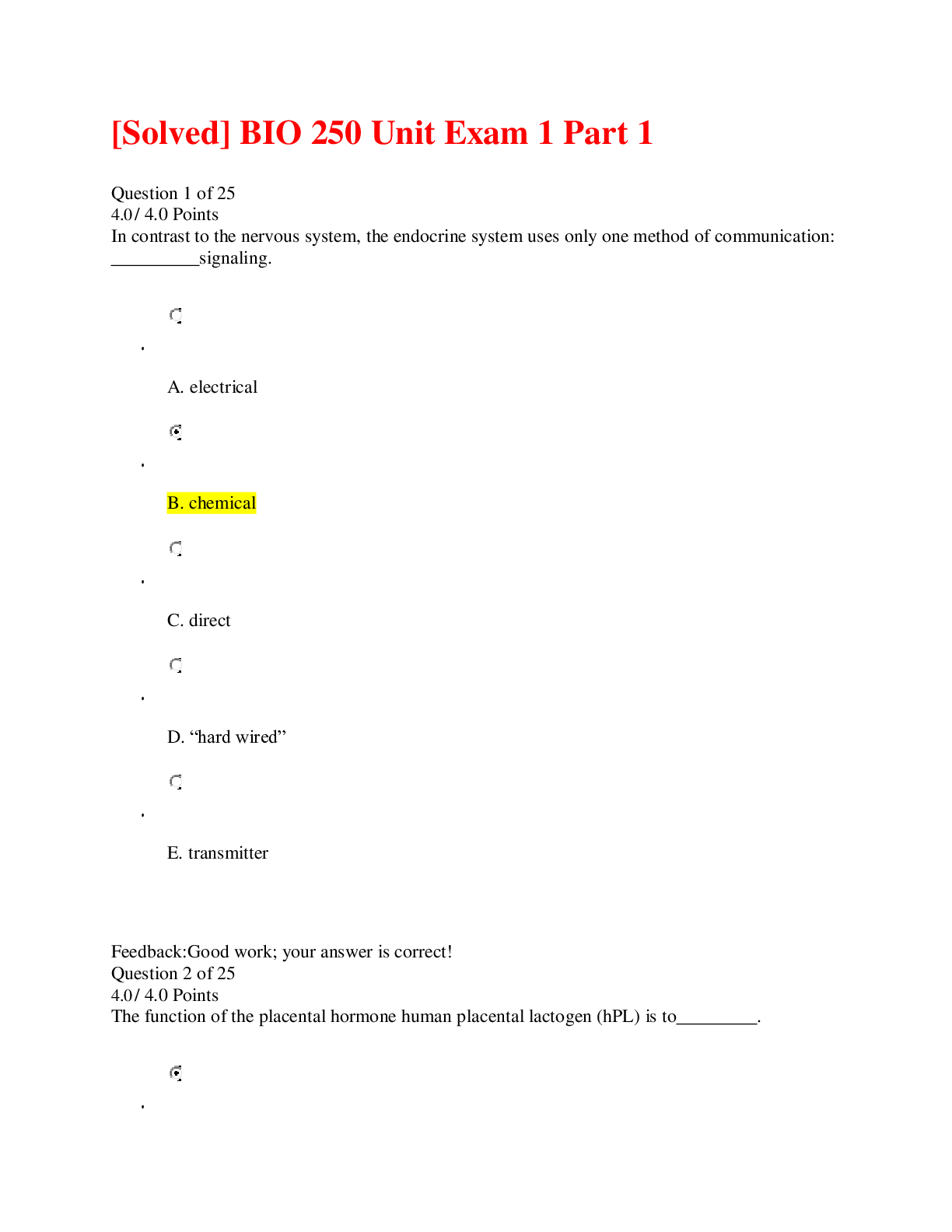
Buy this document to get the full access instantly
Instant Download Access after purchase
Buy NowInstant download
We Accept:

Reviews( 0 )
$15.00
Can't find what you want? Try our AI powered Search
Document information
Connected school, study & course
About the document
Uploaded On
Sep 27, 2021
Number of pages
21
Written in
Additional information
This document has been written for:
Uploaded
Sep 27, 2021
Downloads
0
Views
88

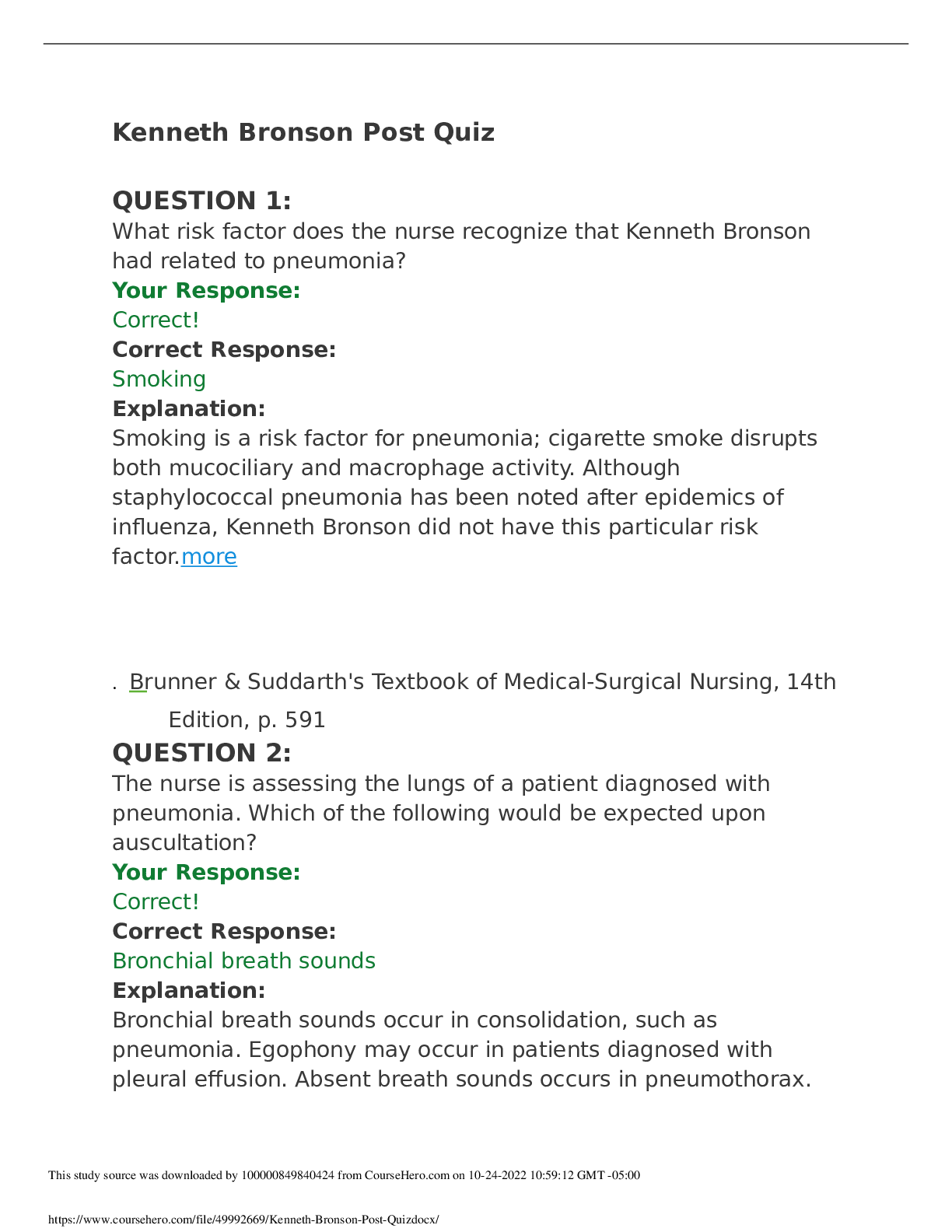



 Questions and Answers 100% VERIFIED.png)
 Questions and Answers 100% correct Solutions.png)








